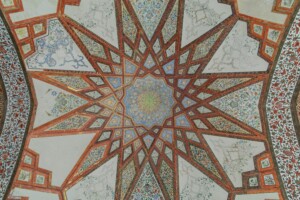
It takes no time at all to locate the center point of a building or house that is a square or rectangular shape. The center of a circle is easy to pin point also. This case study, Locating the Geometric Center, provides illustrative examples of odd-shaped structures in addition to a discussion of the difference between the Geometric Center and the Qi Center, which are not always the same.
This case study is also a good companion file to my trade paperback books, which were all published before 2009. Those books feature the Nine Palace Grid method for dividing up floor plans and I no longer use that method. I share with my students updated files on how the sample floor plans can be viewed differently.
Classical Feng Shui practitioners are broken off into mostly two main camps in terms of how they view floor plans: the Nine Palace grid adherents and the Pie-Shape sector people. I used both for distinct purposes for many years, but made the formal switch around 2012. Technically, both schools could come to the same conclusion about the geometric center, but not always. And by using the pie-shape sector method, everything else that follows is quite different, illustrating how the energy moves and establishes itself through the built space.
This case study also has bonus material, highlighting some of the Chart Types in Flying Star School Feng Shui which are considered “Special House Types.”
EXCERPT:
“With the pie shape sector method, we become more sensitive to the 24 mountains, in a way that the Nine Palace grid method does not make so readily, visually, accessible. One technique which requires the use of the pie shape sector method, is the ideal placement of an elemental remedy based on the 24 mountain divisions. In an ideal situation, a house which sits in the first sector of a direction would have its elemental remedies placed in the first sector of all the directions.
For example, if a house is sitting East-1 and the east sector hosts the 1-x-5 stars, then the best location for the metal element would be in East-1 sector on the floor plan. Of course, if East-1 is not available to use, then the other sectors of East would be usable and a back-up plan. Why would the ideal sub-sector not be available? Well, there could be a number of reasons, mostly architecturally, such as a sector landing in between walls or an area that is furnished in such a way that placing a physical object there would be awkward or impossible. This happens when the ideal location ends up being in a closet (don’t put water fountains inside closets) or other fixtures like where a toilet is or a shower, etc.
Let’s say a house faces and sits in the 3rd sector of any of the eight directions. So, the placement of the elements would ideally be in the third sector of each direction. But let’s say that in one instance that is the entrance and a hallway. Placing an element in that area would literally get in the way of someone easily and safely passing through the area. We are not supposed to be tripping over remedies. Remedies should also be placed in areas where they can support good qi flow and not block it unnecessarily.
Then of course, common sense prevails and the other sectors of the same direction would be the practical location to use.
These 15-degree increments, as specific sectors to work with, are special portals of energy where the qi can enter. Much has been written and observed about the 24 mountains, including personal best directions as well as the precise areas of a house to work with in both time and space. By time and space, I am referring to the Chinese zodiac signs related to twelve of the 24 mountains. For example, the Rat-Zi sector is North-2. That is a location, identified with the compass. But in the Rat Year, the Rat Direction becomes the Tai Sui (Grand Duke). The Tai Sui energy of the year imparts the influence of the planet Jupiter. The timing then of what is relevant to the Rat Sector is an example of time and space.”
This case study synthesizes the geometric center concept with the Qi center, with the Pie-Shape vs. Nine Palace approach. Supportive information is shared in relation to the ideal placement of remedies and the co-mingling of adjacent flying stars.
Author: Kartar Diamond
Company: Feng Shui Solutions (R)
From the Architecture & Design Blog Series
Share This Story, Choose Your Platform!
Go to Top

